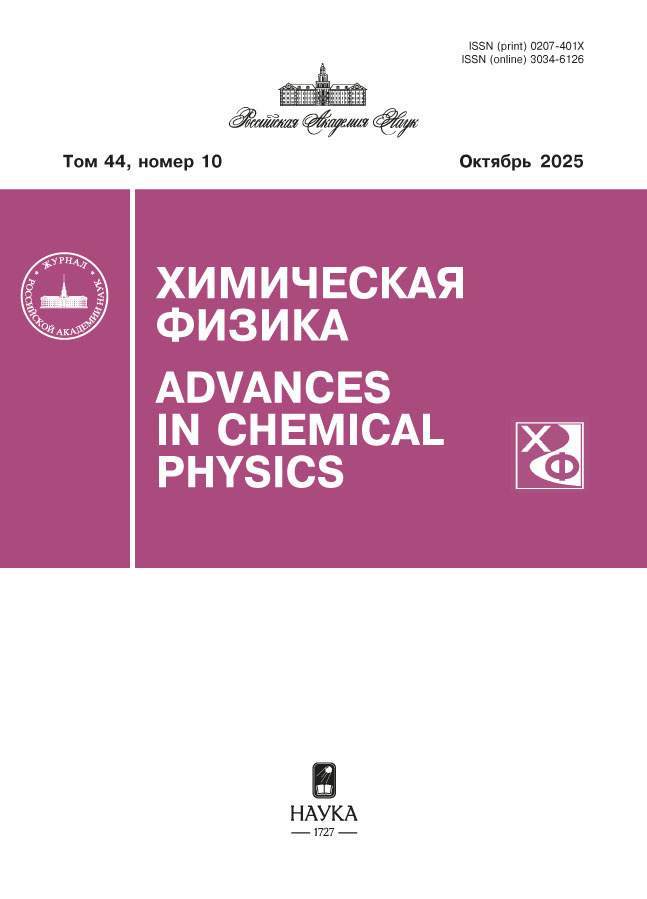Formation of sorption acrylamide foam composites under microwave heating conditions
- Authors: Gorshenev V.N.1, Yakovleva M.A.1
-
Affiliations:
- Emanuel Institute of Biochemical Physics of the Russian Academy of Sciences
- Issue: Vol 44, No 2 (2025)
- Pages: 91-98
- Section: Chemical physics of polymeric materials
- URL: https://cardiosomatics.orscience.ru/0207-401X/article/view/681130
- DOI: https://doi.org/10.31857/S0207401X25020096
- ID: 681130
Cite item
Abstract
The results of the formation of foamed acrylamide sorption composites (SC) from suspensions of various natures under microwave heating conditions are presented. The increase in sorption properties (SP) was carried out due to the additional introduction of inorganic (manganese oxide) and organic (chitosan) sorbents into the acrylamide foam matrix. The production of acrylamide foam composites based on dispersion media with chemical reagents that react with toxic compounds and form sediments in the polymer matrix increases the sorption capacity (SC).
Full Text
About the authors
V. N. Gorshenev
Emanuel Institute of Biochemical Physics of the Russian Academy of Sciences
Email: lina.invers@gmail.com
Russian Federation, Moscow
M. A. Yakovleva
Emanuel Institute of Biochemical Physics of the Russian Academy of Sciences
Author for correspondence.
Email: lina.invers@gmail.com
Russian Federation, Moscow
References
- D. Cormac, Combating marine pollution with oil and chemicals. M.: Transport, P. 365. (1989).
- M.T. Dmitriev, N.I. Kaznina, I.A. Pinigina. II Sanitary-chemical analysis of pollutants in the environment. Directory. M.: Chemistry, P. 367. (1989).
- V.N. Gorshenev, A.A. Ovchinnikov, Yu.N. Novikov. Journal. Phys. Chemistry. 75 (6), 1058 (2001).
- I.V. Kumpanenko, M.V. Dyubanov, N.A. Ivanova, V.V. Novikov, V.I. Krivenko, A.V. Roshchin. Russian Journal of Physical Chemistry B. 15 (6), 1054 (2021). https://doi.org/10.1134/S199079312106021X
- T.E. Nikiforov, N.A. Bagrovskaya, V.A. Kozlov, S.A. Lilin. Chemistry of plant raw materials. 1, 5 (2009).
- S.F. Abdullaev, N.M. Safaraliev, K. Partoev // Chemical Safety. 3 (1), 110 (2019). https://doi.org/10.25514/CHS.2019.1.15009
- D.V. Adamovich, A.E. Arustamov, V.M. Gelis, O.A. Kononenko, V.V. Milyutin // Pat. Rus. No. 2263536. 2005.
- S. Rogovina, S. Lomakin, S. Usachev, A. Yakhina, L. Zhorina, A. Berlin. Appl. Sci. 13, 3920 (2023). https://doi.org/10.3390/app13063920.
- M.V. Bazunova, R.A. Mustakimov, E.I. Kulish. Russian Journal of Physical Chemistry B. 15 (5), 888 (2021). https://doi.org/10.1134/S199079312105002X
- V.V. Lopatin, A.A. Askadsky, A.S. Peregudov, V.A. Berestnev, A.B. Shekhter. High-molecular compounds. Series A. 46 (12), 2079 (2004).
- Yu.V. Karyakin, I.I. Angelov. Pure chemical reagents. M.: Goskhimizdat. P. 584. (1955).
- N.U. Pulatova, O.S. Maksimova. Universum: Chemistry and biology: electron. Scientific Journal. 6 (48), 1 (2018). https://doi.org/10.32743/UniChem.2021.84.6.11853
- R.C. da Silva, S.B. de Aguiar, P.L.R. da Cunha, R.C.M. de Paula, J.P.A. Feitosa. Reactive and Functional Polymers. 148, 104491 (2020). https://doi.org/10.1016/j.reactfunctpolym.2020.104491
- V. Singh, A. Tiwari, D.N. Tripathi, R. Sanghi. Polymer. 47, 254 (2006).
- V.F. Gromov, M.I. Ikim, G.N. Gerasimov, E.Yu. Spiridonova, L.I. Trakhtenberg. Russian Journal of Physical Chemistry B. 16 (1), 138 (2022). https://doi.org/10.1134/S1990793122010055
- W. Kexin, M. Hui, P. Shengean, Y. Chun, W. Miaoting, Y. Jing, W. Xiaoke, C. Wei, Z. Anatoly. Journal of Hazardous Materials. 362, 160 (2019).
- A.L. Kovarsky, O.N. Sorokina, V.N. Gorshenev, A.P. Tikhonov. Journal of Physical Chemistry. 81 (2), 364 (2007).
- V.E. Kirillov, G.Y. Yurkov, M.S. Korobov, A.S. Voronov, V.I. Solodilov, V.M. Bouznik. Russian Journal of Physical Chemistry B. 17 (6), 1346 (2023). https://doi.org/10.1134/S1990793123060040
Supplementary files















